Sphira is a photobioreactor-cum-spherificator (developed in Claudia Pasquero’s Studio 2 in IAAC) that makes Spirulina caviar from algae. Sphira was developed in Iaac in Claudia Pasquero’s Introductory Studio 2 (MAA 01 2017-2018) by Mario Alberto Espinoza Membreño, Eduardo Chamorro Martin, Elliott Santos and Timothy Magara.
The Kickstarter campaign of Sphira aims to redesign and re-purpose Sphira from a fancy lab experiment to a utility item for every kitchen, making superfood Spirulina easily accessible to all.
</p>

Sphira is the brainchild of a group of four architects pursuing their Master of Advanced Architecture in IAAC (Institute for Advanced Architecture in Catalonia), Barcelona, Spain.

Introducing Sphira
Sphira began as a studio project aimed at designing a process for crafting Future Food out of Spirulina, widely accepted as a superfood with limitless potential to be tapped into. Sphira’s photo-bioreactor and spherificator sparked a lot of interest within the Institute and outside. Chef Ignacio de Juan-Creix came on board and offered a lot of useful tips and guidance and helped the team develop flavours and combinations for Sphira. The team also worked hard to design a functioning prototype that also has a fun futuristic look – half mad-scientist’s lab, half witch’s cauldron.

Spirulina Food
The day of the presentation saw a lot of buzz around Sphira. The multi-apparatus set-up and Spirulina Caviar drinks were an instant hit. Curiosity brought many to the Sphira table and more than a few came back for seconds and brought friends along. In addition to downing some cocktails, some had fun playing with the apparatus, using the app to make their own caviar. It is not often that you come across something healthy and tasty that looks quite as slick as this Spirulina Caviar.
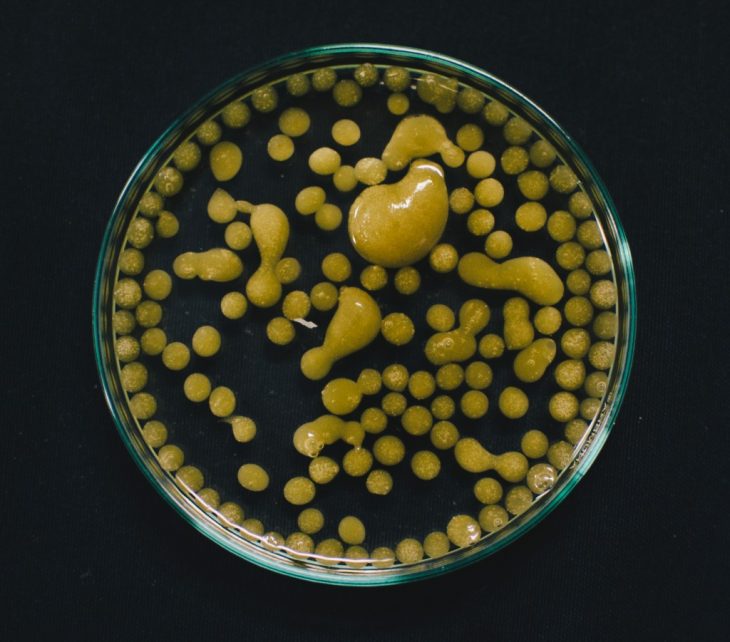
Spirulina Caviar from Sphira
Days after the presentation was wrapped up Sphira was alive through social media with many posting their Sphira moments on Instagram and FaceBook and people still come around asking for updates. This enthusiasm from the initial crowd to sample Sphira makes us hope that it is lack of availability and not skepticism that keeps Spirulina away from the regular person’s diet.
So we decided to give launching Sphira a real go! This time around not as an experiment for a class assignment but as a lifestyle and utility tool for every home.
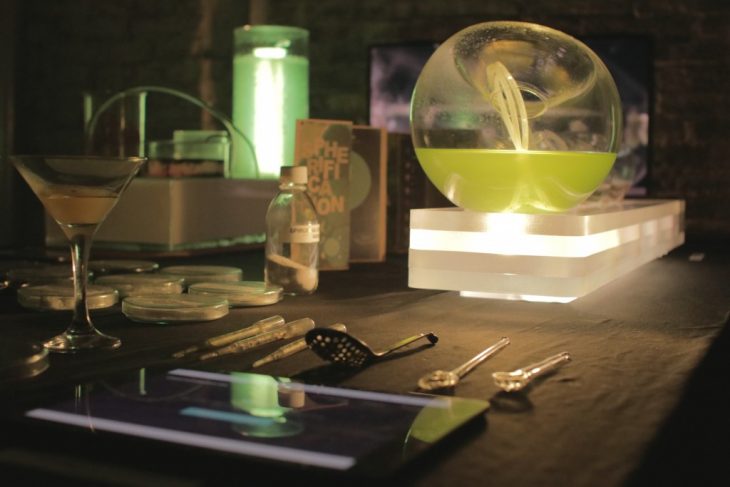
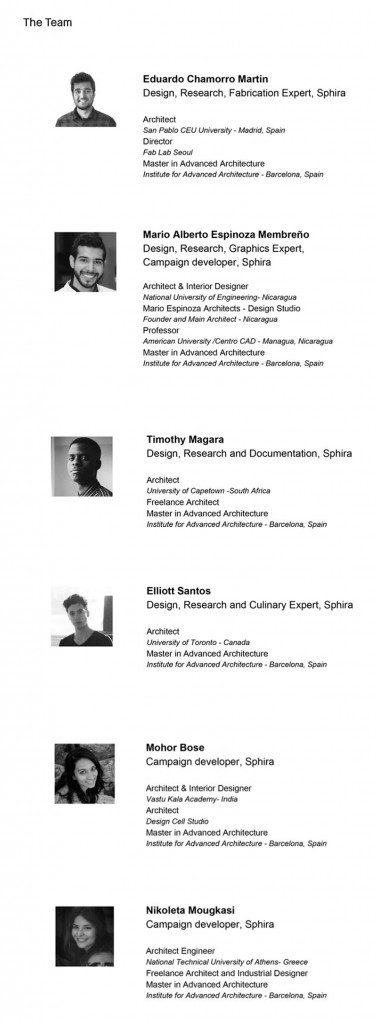
The Sphira Team
Why Sphira?
A cow on overage releases between 70 and 120 kg of Methane per year. Methane is a greenhouse gas like carbon dioxide (CO2), but the negative effect of methane on the climate is 23 times higher than the effect of CO2. Therefore the release of about 100 kg Methane per year from each cow is equivalent to about 2300 kg CO2 per year. The Food and Agriculture Organization of the United Nations (FAO) states that agriculture is responsible for 18% of the total release of greenhouse gases worldwide (this is more than the whole transportation sector), making it the no. 1 cause of global warming. We cannot deny that farming has a major impact on global warming. Since farming is basically serving the consumer’s demand for food, we must reconsider the modes of our nourishment. With increased prosperity, people are consuming more meat and dairy products every year. Global meat production is projected to more than double from 229 million tonnes in 1999/2001 to 465 million tonnes in 2050.
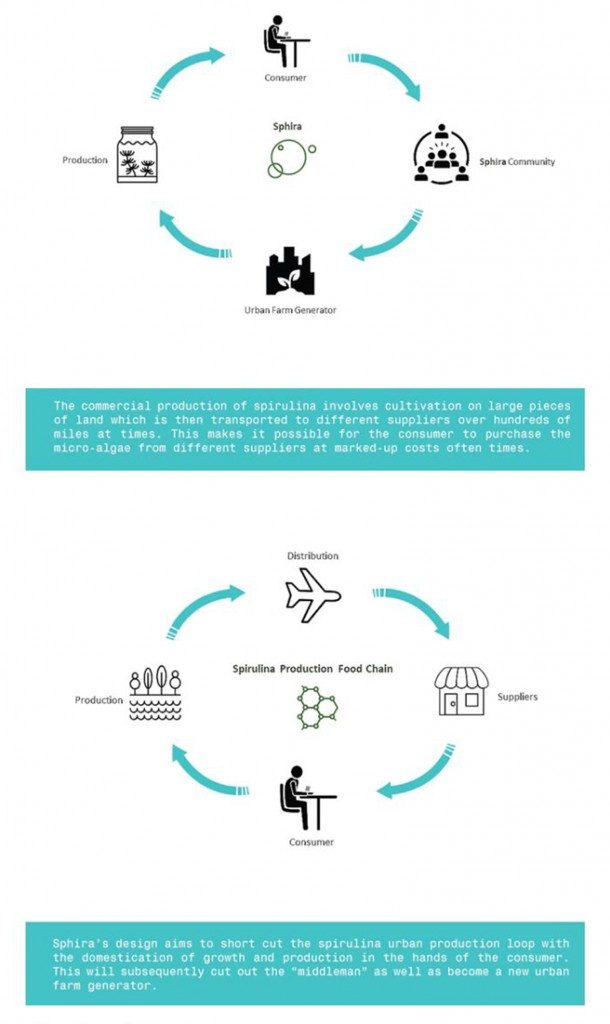
Cutting out the Middle Man
How it works
Sphira is a multi-scalar apparatus that focuses on bringing public attention to the portable cultivation and innovative consumption of spirulina. By combining a working photo-bioreactor with the modern gastronomy process of spherification, it seeks to find the best possible solution to an edible sphere by-product. This fully automated device controlled by an interactive mobile application produces spheres containing high concentrations of live spirulina mixed with organic flavourings. By having a closed system with precise nutrient controls our bioreactor attempts to produce spirulina void of flavour. This allows us to add various components such as coconut and pineapple juice to a concentrated spirulina solution that can then be formed into edible spheres.
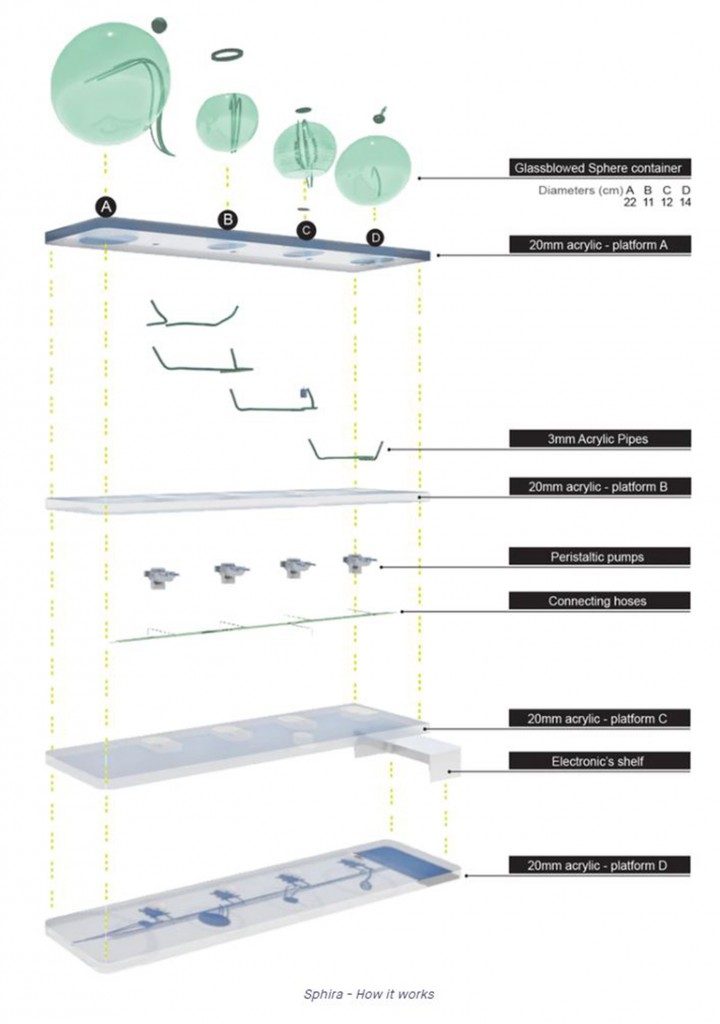
So let’s break it down to six simple steps:
Step 1: add water and algae in the photobioreactor container
Step 2: desired spirulina density is achieved within the bioreactor and extraction begins
Step 3: filtering the solution
Step 4: mixing the solution with sodium alginate and flavouring
Step 5: spherification process begins – the spherification “fountain” drips into a calcium chloride bath forming the spheres that are rinsed with fresh coconut or spring water
Step 6: your spirulina spheres are ready for consumption!!
Why do we need your help
The prospect of Algae to Spirulina with just one device was super exciting and with our current final prototype we did manage the process but we would be lying if we didn’t admit that there were a whole host of problems along the way.
To detail some of them out:
Algae takes a lot of time to harvest (to be introduced into our photobioreactor) and in today’s market is not that easy to source – suppliers are few and far in between. We are designing Sphira as a utility item for all, not a fancy experiment for a bar/restaurant, so we need to either find local partners to supply or redesign to introduce a chamber with a catalyst to expedite the harvesting process.
The transfer of fluid from the first container (photo-bioreactor) to the second container (mixer) is a process that still has a lost of speed bumps to be ironed out. We had to deal with leakage, blockage and frequently replacing or repairing the peristaltic pumps that would often malfunction We want to add a fifth container that automatically strains the liquid (to be recycled) and leaves behind only the caviar to be extracted with more ease
From a design point of view, we want to create a new prototype that has the same chic look of the current Sphira Model but is more economical (spatially and financially) so Sphira in every home can become a reality. Fixing these issues and refining the design and processes of Sphira will involve a lot more research, material testing, collaborations with local harvesters, experts and a lot more prototyping.
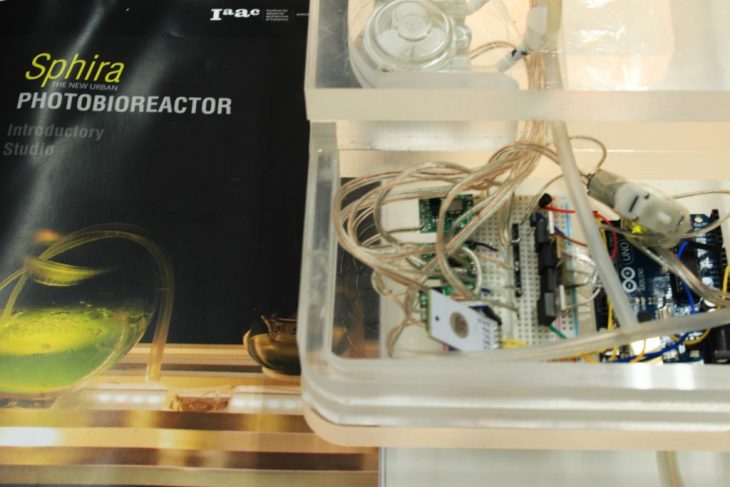
The Brain
The benefits of Spirulina are hard to ignore and the possibilities of Spirulina caviar are endless. So stand by us for the next few algal explosions (somewhere some people are making Spirulina sea salt scrubs so this won’t kill us) and by the end of it we should all be looking at Sphira in every home as a reality.
We are not designing a kitchen appliance, we are designing The Future of Food and we want you to help us by investing in your Future.
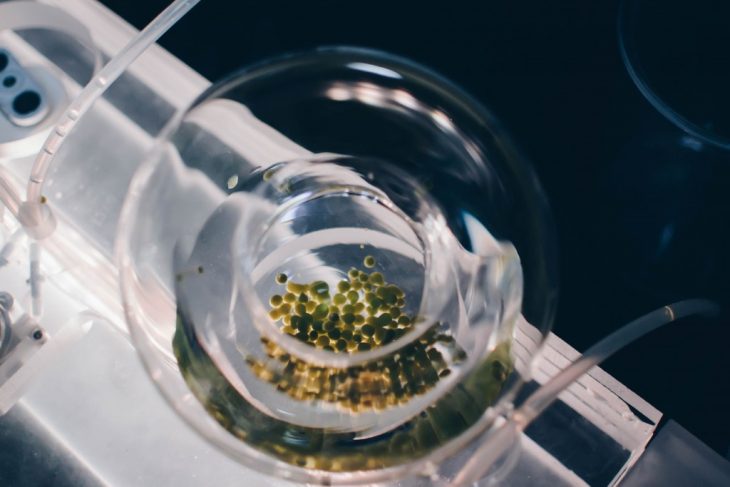
Spirulina Caviar in Production
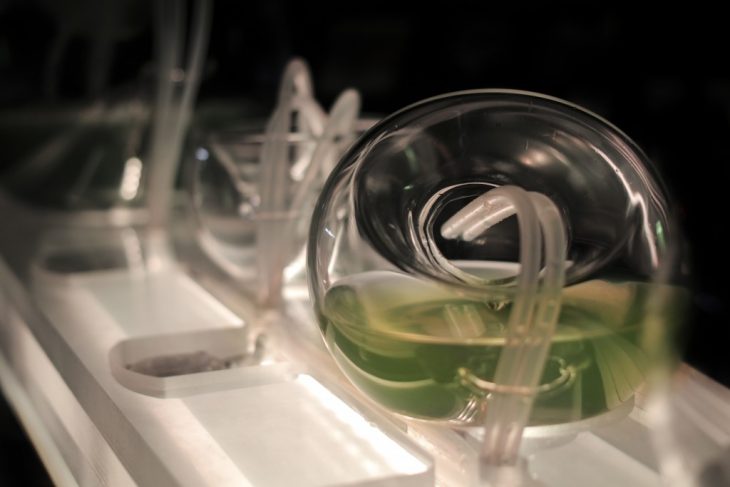
What do we need the funding for
Consultant experts coming in to help us refine the device and the output
To rent a space to carry out these mad-scientist experiments
Resources for materials and fabrication
Spirulina is a new hot topic on the global health and culinary scenario and a lot of research is in process at the moment. To make sure we don’t fall into quicksand pits of legal conflicts over copyrights and patents, we would like to have a Legal Aid on board to help us toe the line and protect our Intellectual and Industrial Property along the way.
Making sure you get quality rewards for your efforts
We already have an app that automates and controls the Sphira device but we want to bring in some UX/UI Designers to take this app to the next level and add a website where we can share updates, have a FAQ section, add images and videos and in time even share recipes using Sphira’s Spirulina Caviar. The goal is not to build a company, but a community and we want you to participate!
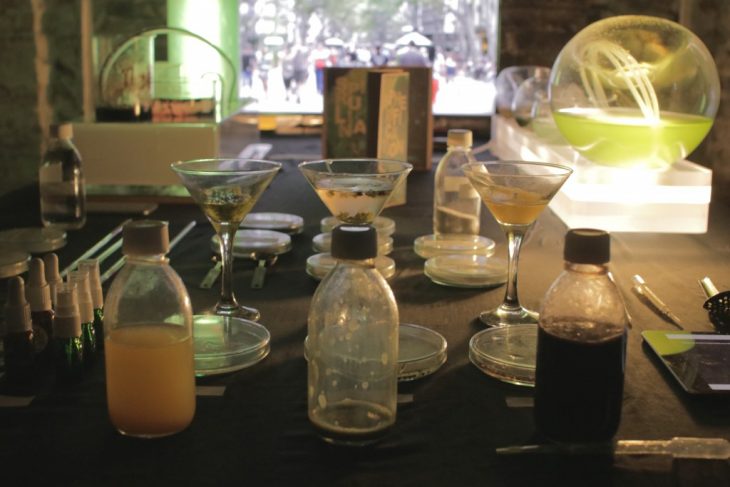
- While Algae/Spirulina has existed in the food chain for millennia and its benefits are well known, today it is still in the “unconventional” and “unexplored” territory as a culinary ingredient. We need to really put on our thinking caps and do a lot of Research and Development in terms of the device and its output and how to diversify and integrate it into a daily consumption palate, not as a nutrition supplement but as a food ingredient. To this end we would need:
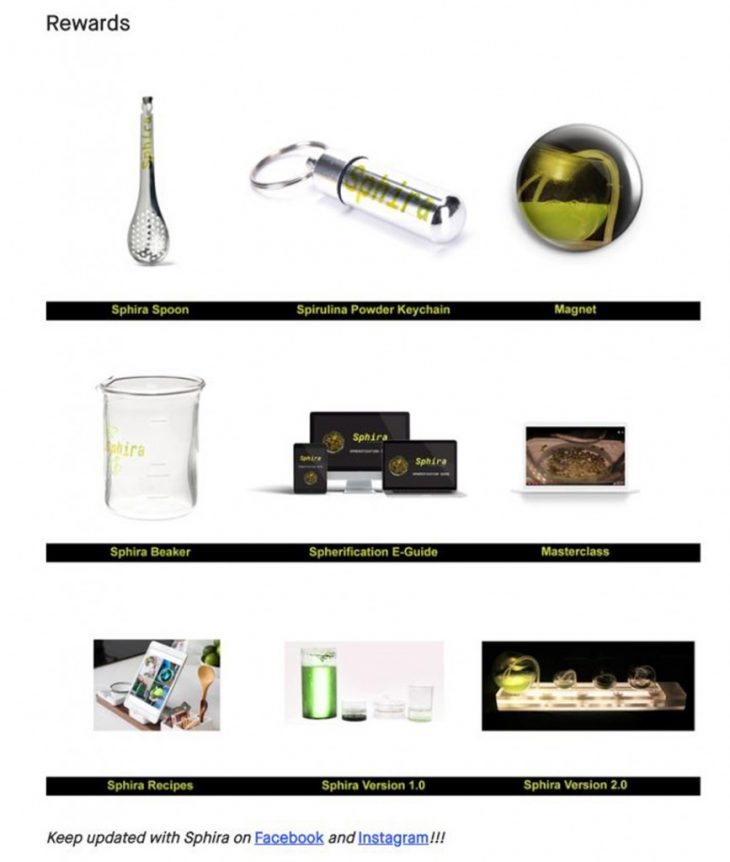
The Kickstarter Rewards
Risks and challenges
Algae/Spirulina as a food supplement is much discussed in health/gastronomy platforms today but like all new and experimental substances there are a lot of hurdles when working with them. As mentioned before, Spirulina is difficult to harvest or source and this gap between demand and supply needs to be fixed for Sphira to really take off.
Another factor that is difficult to account for is time. When working on new prototypes, there are unforeseen mechanical failures in the device or sometimes even the chemical compositions. Trial and error fixes these, but our crystal ball isn’t always accurate on the number of trials needed 😛
Lastly, we are a team of young architects, not scientists, not nutritionists, not chefs, so there’s a lot more learning (and failing and trying again) involved for us in this venture but we have collaborated with chefs and researchers to get to where we are now and we hope to bring on board a lot more experts soon.
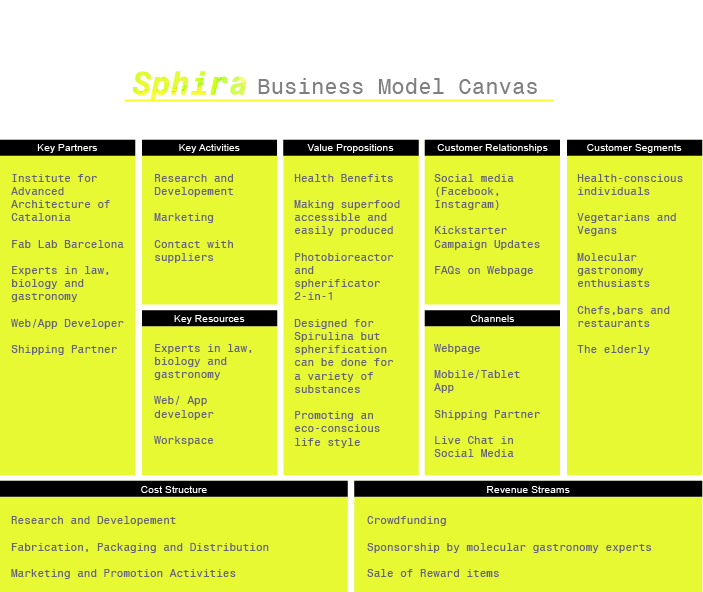
Sphira Business Model Canvas

Sphira presence on FaceBook

Sphira presence on Instagram
MAA01 2017-2018 Master in Advanced Architecture Students: Mario Alberto Espinoza Membreño, Nikoleta Mougkasi, Mohor Bose Faculty: Anna Pla Catala